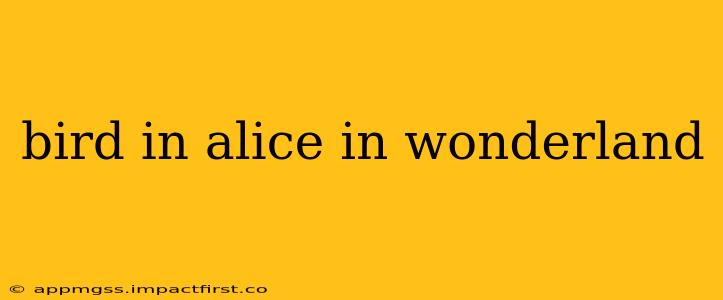Lewis Carroll's Alice's Adventures in Wonderland is a fantastical journey brimming with eccentric characters and nonsensical situations. While the Mad Hatter, the Cheshire Cat, and the Queen of Hearts often steal the spotlight, the birds of Wonderland deserve a closer look. They subtly contribute to the story's atmosphere and, upon closer examination, reveal surprising depths. While not as prominent as other characters, their presence adds another layer to the whimsical world Carroll created. This exploration will delve into the avian inhabitants of Wonderland, analyzing their roles and symbolism. We'll also tackle some frequently asked questions about these feathered friends.
What birds are in Alice in Wonderland?
While not explicitly named in every instance, several avian species grace the pages of Alice's Adventures in Wonderland. We encounter various types of birds, primarily depicted in their roles within the fantastical narrative. There's the Dodo, a flightless bird that leads the Caucus-race, and various unnamed birds in the Mad Hatter's tea party and other scenes, often described as singing or simply present as part of the chaotic Wonderland landscape. The lack of specific identification adds to the dreamlike and surreal quality of the story. The ambiguity allows readers to project their own interpretations onto these feathered figures.
What is the significance of the Dodo in Alice in Wonderland?
The Dodo, famously leading the Caucus-race, holds particular significance. Carroll himself, Charles Lutwidge Dodgson, was known to have a rather self-deprecating personality. The Dodo, now extinct, reflects this self-awareness; it's a quirky, somewhat clumsy character who presides over a nonsensical competition. This subtly mirrors Carroll's own perceived oddity within society. The Dodo's leadership of a race with no clear winner reflects the illogical nature of Wonderland and the lack of conventional rules. Further, the Dodo's ultimate declaration that “everybody has won and all must have prizes” is a gentle commentary on societal norms and expectations.
Are there any symbolic meanings behind the birds in Alice in Wonderland?
The birds in Alice in Wonderland are less about specific symbolism and more about contributing to the overall atmosphere. They often represent the unpredictability and topsy-turvy nature of the world Alice finds herself in. Their presence adds to the chaotic and dreamlike quality of the narrative. They're part of the overall surreal landscape, rather than acting as independent symbols with clear-cut meanings.
Do the birds speak in Alice in Wonderland?
While the book features anthropomorphic characters, the birds aren't typically depicted as speaking in the way that the Mad Hatter or the Caterpillar do. They might sing, or be described as making bird-like noises, but they don't engage in the verbal discourse central to many of the other characters' interactions with Alice. This lack of explicit verbal communication again contributes to the sense of mystery and surrealism within the story.
What role do the birds play in the overall narrative of Alice in Wonderland?
The birds primarily act as part of the background, enriching the atmosphere and setting of Wonderland. They're not central to the plot but add to the overall sense of whimsical absurdity. Their presence enhances the feeling of being lost in a dream, reflecting the illogical and fantastical elements of the narrative. Their muted roles reinforce the feeling of chaos and disorientation that Alice experiences throughout her adventure.
In conclusion, while not the main characters, the birds in Alice in Wonderland are vital components of the story's fantastical setting. Their presence, even in their quiet roles, contributes significantly to the dreamlike and nonsensical atmosphere that makes Carroll's work so enduringly captivating. They are a subtle yet effective element in the tapestry of Wonderland, enriching the overall narrative with their silent, yet evocative, presence.
